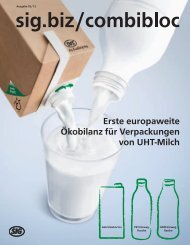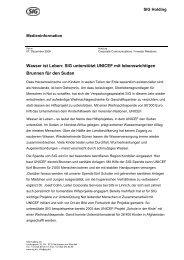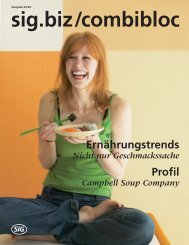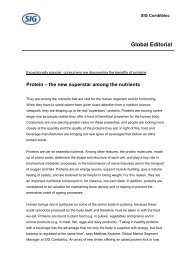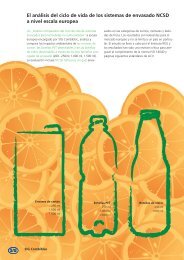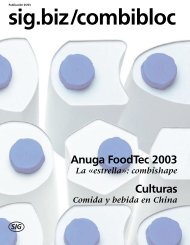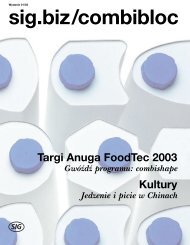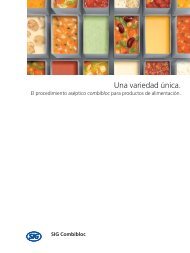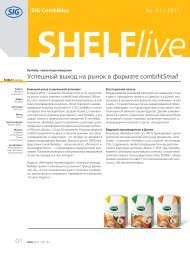English - SIG Combibloc
English - SIG Combibloc
English - SIG Combibloc
Create successful ePaper yourself
Turn your PDF publications into a flip-book with our unique Google optimized e-Paper software.
Edition 01/08<br />
sig.biz/combibloc<br />
High speed<br />
Efficiency key to success
Editorial<br />
Dear Readers,<br />
If you want to stay competitive, you have<br />
to keep production running effi ciently.<br />
Maximum operating effi ciency is the goal for<br />
which <strong>SIG</strong> <strong>Combibloc</strong> strives when working<br />
with its customers around the world. As new<br />
Head of the Global Sales, Service and Marketing<br />
activities at <strong>SIG</strong> Comibloc, this will be an<br />
important topic for me in the future.<br />
Our new high-speed fi lling machines make<br />
this goal a reality. In this issue’s cover story,<br />
we would like to introduce a few of these<br />
machines, including the new CFA812 for<br />
medium size packages with an output of<br />
12.000 packages per hour, as well as the<br />
new CFA124 and CFA724, now the fastest<br />
aseptic fi lling machines in the world for<br />
small size carton packages. These machines<br />
can fi ll 24,000 carton packs per hour in<br />
combiblocMini or combiblocSmall respectively,<br />
increasing production volumes by up to 100<br />
per cent – and making the day as productive<br />
as though there were 48 hours in it!<br />
The examples of Cemil (Brazil) and Friesland<br />
Foods Foremost (Thailand) give you a taste<br />
of the high-speed fi lling machines CFA812<br />
resp. CFA124 in action.<br />
But effi cient production alone is not enough<br />
to keep you one step ahead of the competition.<br />
Read how our customers are responding effectively<br />
to changing consumer needs, including<br />
offering a variety of taste experiences and<br />
new ingredients that are in tune with the<br />
growing health-consciousness of consumers.<br />
Not to mention innovative packaging solutions<br />
that use new formats, volumes and opening<br />
solutions to reach new target groups and open<br />
up completely new areas of application.<br />
Imprint<br />
sig.biz/combibloc, spring 2008 Published by <strong>SIG</strong> <strong>Combibloc</strong> GmbH, Rurstrasse 58, 52441 Linnich, Germany Editors Ingo Büttgen, Bianca Roßkopf, Stefanie Galinski,<br />
Fernanda Azevedo e Silva, Dr. Anna Avchukova, Kanokthip Chatchaidamrong, Dr. Isabella Classen, Matthias Enste, Paola Fontanelli, Luciana Galvao, Cindy Haast, Angela Peitz,<br />
Michèle Quelle, Paul Thelen, Heike Thevis, Melanie Wagner, Wojciech Wroczynski Concept and design GOERLICHUNDSOHN Werbeagentur oHG, Düsseldorf<br />
Pictures <strong>SIG</strong> <strong>Combibloc</strong>, Image Source, Holzabzatzfonds Bonn Lithography and print Laser-Litho4 Digitale Medien GmbH, Düsseldorf Contact Telephone: +49 2462 79-0,<br />
Fax: +49 2462 79-2519, E-Mail: bianca.rosskopf@sig.biz Internet www.sig.biz. sig.biz/combibloc is published in German, <strong>English</strong>, Spanish, French, Italian, Portuguese, Polish,<br />
Russian and Chinese. All rights reserved. Articles indicated as being contributed by other writers do not necessarily reflect the views of the publisher. No part of this publication<br />
may be reproduced or electronically distributed without the prior permission of the editorial team.<br />
sig.biz/combibloc 01/ 08<br />
We wish you happy reading, and a prosperous<br />
new year in 2008!<br />
Rolf Stangl, Head of Global Market Operations<br />
<strong>SIG</strong> <strong>Combibloc</strong>
Contents 2/3<br />
Contents Page<br />
Editorial & imprint 2/3<br />
News<br />
Delicious desserts, conveniently packaged 4<br />
Arabian Beverage Company and <strong>SIG</strong> <strong>Combibloc</strong> celebrate their long association with the production<br />
of the billionth carton, and whet the appetite for delicious desserts.<br />
New closure for even greater convenience 5<br />
In addition to its existing formats, Gostyn now also offers its customers a small package size<br />
with a handy opening solution.<br />
Title<br />
High speed and effi ciency are the keys to success 6<br />
If you want to stay competitive, you have to keep production running efficiently.<br />
So <strong>SIG</strong> <strong>Combibloc</strong> strives for maximum operating efficiency with its new high-speed filling machines.<br />
World record in Thailand: fastest aseptic filling machine in operation<br />
at Foremost 12<br />
With an output of 24,000 carton packs per hour, previous production volumes can be doubled –<br />
as if there were 48 hours in the day. At Friesland Foods Foremost, Thailand, the worldwide fastest<br />
aseptic filling machines for small size carton packages are already in use.<br />
World premiere in Brazil: grand entrance for high-speed machine at Cemil 14<br />
Two new high-performance CFA 812 filling machines are now in operation at Cemil.<br />
They are not only making their world premiere there, but they are also providing for even<br />
greater efficiency at the plant of the Brazilian dairy manufacturer.<br />
Markets<br />
10 years in Russia – a decade of growth 16<br />
<strong>SIG</strong> <strong>Combibloc</strong> is celebrating ten years in Russia and can look back on a dynamic history.<br />
Facts & trends<br />
Brazil: dairy market makes its move 20<br />
Having played a peripheral role in the past, Brazil’s dairy industry is now well on the way<br />
to making its mark as a net exporter.<br />
Not everything that looks like milk comes from a cow 24<br />
Consumers are increasingly turning away from products containing cow’s milk. Manufacturers are<br />
responding to this trend with dairy-free alternatives made from soy, oats, rice, corn and almonds.<br />
Unusual fl avours make soy drinks a healthy, trendy beverage 26<br />
Modern consumers want variety and new taste experiences. And the soy drink market wants<br />
the same thing.<br />
Environment<br />
Joint signature of a world-wide self commitment 30<br />
<strong>SIG</strong> <strong>Combibloc</strong> supports traceability of wood fibre in the beverage carton.<br />
sig.biz/combibloc 01/ 08
News<br />
Delicious desserts, conveniently<br />
packaged<br />
A lasting partnership between the Arabian Beverage Company (ABC) and <strong>SIG</strong> <strong>Combibloc</strong> resulted<br />
in 2007 not only in an expanded product range but in a quite special statistic: the Kuwait-based<br />
company took delivery of its billionth combibloc pack.<br />
ABC is expanding its product range to<br />
include ice cream and dessert crème in<br />
aseptic carton packs. With its new products,<br />
ABC is primarily targeting restaurants and<br />
caterers.<br />
The ice cream blends, in Chocolate and<br />
Vanilla, are offered in combiblocSlimline<br />
1,000 ml. A dessert crème is available in<br />
combiblocSmall 250 ml on the Kuwaiti, Iraqi<br />
and Saudi Arabian markets. The dessert<br />
crème is ideal for use in baking or to add a<br />
touch of sophistication to a fresh fruit salad.<br />
sig.biz/combibloc 01/ 08<br />
Success factors: production and<br />
packaging<br />
ABC, founded in Kuwait in 1960, aims<br />
to offer the best-tasting, premium quality<br />
products made from the finest ingredients.<br />
In achieving this objective, the quality of the<br />
ingredients and the production methods play<br />
an important role for the company. “In the<br />
past few years, ABC has developed into the<br />
leading regional provider of juice, nectar and<br />
fruit juice drinks, as well as dairy products,<br />
water and energy drinks, and we want to<br />
continue to hold this market position. In addition<br />
to using the best ingredients, premium<br />
packaging solutions are of crucial importance<br />
in ensuring our products are of first-class<br />
quality“, says Adnan Al-Mousa, General<br />
Manager at ABC.<br />
Partnership with expertise<br />
The product protection characteristics of<br />
aseptic carton packaging, in combination with<br />
high-performance machine technology, have<br />
led ABC to intensify its collaboration with<br />
<strong>SIG</strong> <strong>Combibloc</strong>. Ten <strong>SIG</strong> <strong>Combibloc</strong> filling<br />
machines are now in use at ABC facilities<br />
and in 2007 the billionth combibloc sleeve was<br />
delivered.
New closure for even greater<br />
convenience<br />
Since 1995 well-known Polish dairy co-operative Gostyn has offered a range of products<br />
in aseptic carton packs from <strong>SIG</strong> <strong>Combibloc</strong>.<br />
In October 2007 combifitSmall joined<br />
combiblocCompact and combiblocSlimline,<br />
adding a handy format for small carton sizes.<br />
Fitted with the practical combiSmart screw<br />
cap, this makes it possible for the first time<br />
for Gostyn to offer condensed milk and UHT<br />
cream in a small size, recloseable carton pack<br />
from <strong>SIG</strong> <strong>Combibloc</strong>.<br />
A handy kitchen aid<br />
When it comes to products such as condensed<br />
milk and cream, combifitSmall with<br />
combiSmart is a real alternative to plastic.<br />
The small carton size is perfect as handy<br />
kitchen aid – the wide opening allows drip-<br />
free pouring and enables portions to be measured<br />
out exactly. The carton is easily reclosed,<br />
prevents leakage, and protects the contents<br />
from external odours and flavours when<br />
stored in the refrigerator after opening.<br />
Performance through flexibility<br />
For Gostyn, aseptic filling technology<br />
from <strong>SIG</strong> <strong>Combibloc</strong> means the company’s<br />
product range can be flexibly adapted to suit<br />
the needs and demands of the market and<br />
the consumer. The ability to fill the combibloc<br />
and combifit package formats in a variety of<br />
volumes using a single machine is an important<br />
factor for SM Gostyn.<br />
News 4/5<br />
This flexibility makes it possible for the<br />
dairy co-operative to give its products the<br />
most favourable positioning at PoS, attracting<br />
maximum consumer interest.<br />
Market leader with a long tradition<br />
SM Gostyn – the current market leader<br />
for condensed milk – can look back on a<br />
history spanning over more than 100 years.<br />
The company’s products have already received<br />
many awards for their quality.<br />
sig.biz/combibloc 01/ 08
Title<br />
High speed and effi ciency are<br />
the keys to success<br />
<strong>SIG</strong> <strong>Combibloc</strong>’s high-performance flexible filling machines are designed to deliver optimal<br />
operating efficiency for its customers. This is the credo by which the company operates, enabling<br />
<strong>SIG</strong> <strong>Combibloc</strong> to meet the market’s demands for high speed and greater output while still<br />
delivering the same high quality and flexibility.<br />
sig.biz/combibloc 01/ 08
In 1997 <strong>SIG</strong> <strong>Combibloc</strong> became the first<br />
manufacturer to launch a filling machine that<br />
could fill 10,000 aseptic carton packs an hour<br />
in volumes from 500 to 1,000 ml. In 2006,<br />
by using servo drives on the filling line,<br />
the company increased the output of the<br />
filling machines for combiblocSlimline and<br />
combiblocStandard by 20 per cent, to 12,000<br />
cartons per hour. Now by doubling the output<br />
of the aseptic filling machines from 12,000 to<br />
24,000 carton packs per hour for the small size<br />
packages combiblocSmall and combiblocMini,<br />
<strong>SIG</strong> <strong>Combibloc</strong> has set the bar high with an<br />
unbeatable top speed.<br />
But speed is not everything. Speed alone<br />
is not a reliable indicator of the efficiency of<br />
a filling line. So operating efficiency is the<br />
credo that <strong>SIG</strong> <strong>Combibloc</strong> is following in the<br />
design of its new high-performance filling<br />
machines.<br />
Fast and flexible<br />
With the development of its new highspeed<br />
machines, <strong>SIG</strong> <strong>Combibloc</strong> is responding<br />
to market demands. The growing movements<br />
towards internationalisation and consolidation<br />
are leading to increasingly fierce competition<br />
among food and drinks manufacturers,<br />
and this in turn makes it more vital than ever<br />
that production be as efficient as possible.<br />
Two clear trends have emerged. One is<br />
‘differentiation’, where flexibility plays a key<br />
role, and the other is ‘efficiency’.<br />
Firstly, manufacturers want to move<br />
away from standard products, and increasingly<br />
are offering products with added value,<br />
to reach new target groups and to make their<br />
products stand out from the competition. One<br />
example of this is the UHT yoghurt drink<br />
with pieces of real fruit offered by Mengniu<br />
Dairy Industry (we reported on this in issue<br />
02/2007). However, this ‘added value’ ethic<br />
applies not only for the products themselves<br />
but also for the packaging. The format and<br />
volume flexibility of the <strong>SIG</strong> <strong>Combibloc</strong><br />
system makes it possible to create added<br />
value by enabling manufacturers to respond<br />
Title 6/7<br />
quickly and flexibly to changing market<br />
needs and differentiate their products appropriately.<br />
Efficiency is what counts<br />
But the products still need to be manufactured<br />
efficiently, and high standards of<br />
quality must be maintained throughout the<br />
manufacturing process. Another factor to be<br />
considered is that it is not the speed of the<br />
filling machines alone that determines the<br />
cost effectiveness of the complete filling line.<br />
In fact, the key factors are keeping wastage<br />
as low as possible and maintaining continuous,<br />
smooth production without long periods<br />
of machine downtime. To do this, the filling<br />
line needs to be viewed as a total integrated<br />
system. The filling machine is not a standalone<br />
unit but part of a system of interdependent<br />
components that must be precisely<br />
harmonised with one another in order to<br />
work efficiently. Finally, the overall operating<br />
costs of the system must be factored into the<br />
calculation, so that its cost-effectiveness can<br />
be worked out. And as markets become more<br />
competitive, this is becoming increasingly<br />
important.<br />
sig.biz/combibloc 01/ 08
Klaus Andresen (Technical Director,<br />
<strong>SIG</strong> <strong>Combibloc</strong> Asia), Matthias Enste (Director<br />
Marketing and Business Development,<br />
<strong>SIG</strong> <strong>Combibloc</strong> Asia) and Luc Viardot (Product<br />
Manager combibloc/combifit) were interviewed<br />
on the subject of ‘high speed and efficiency’.<br />
“Modern filling machines may be capable of<br />
filling 20,000 packages in an hour. But how<br />
much of that is waste?” asks Andresen. “Speed<br />
doesn’t tell the whole story when it comes<br />
to the actual efficiency of a machine”, Luc<br />
Viardot confirms. “On the contrary, output is<br />
the key factor – and closely linked to this is<br />
keeping wastage rates low. Ultimately, it’s the<br />
actual output that’s crucial for the beverage<br />
sig.biz/combibloc 01/ 08<br />
manufacturer – it indicates the true efficiency<br />
and profitability of a facility”.<br />
The essential questions, therefore, are:<br />
how long can low wastage production be<br />
maintained at a stable rate at a defined speed?<br />
How long can a consistent production be<br />
maintained without any trouble in the downstream?<br />
And what does the upstream capacity<br />
look like?<br />
Matthias Enste also looks at the development<br />
of new high-speed machines from<br />
the viewpoint of the food manufacturers.<br />
“Our customers find themselves in a difficult<br />
position, because they’re expected to act as<br />
both ‘operational champions’ and brand producers.<br />
Whether you’re at the upper or the<br />
lower end of the price range, the driving force<br />
in the market is ‘value for money’. A U&A<br />
study carried out by a research institute in<br />
Thailand showed that consumers consistently<br />
cite ‘value for money’ as the main<br />
reason for purchasing a product, both for<br />
‘operational champion’ products and for<br />
premium products.<br />
As a systems manufacturer of packaging<br />
and filling machines, this is where we come in.<br />
Because we make sure system costs are competitive,<br />
we can help our customers to remain<br />
competitive. No other single factor has influ-
enced the way we design our machines as<br />
much as the manufacturer’s need to achieve<br />
greater output while maintaining the advantages<br />
of the aseptic carton pack. Beverage<br />
manufacturers are consumer-centric and marketing-savvy.<br />
They look at the overall plant<br />
efficiency and the system costs. Ultimately,<br />
they have to offer value to the consumer. As<br />
packaging suppliers, we want and need to be<br />
part of this value-creation chain. We’re no<br />
longer looking just at the price of packaging<br />
materials or the speed of the filling machine”.<br />
<strong>SIG</strong> <strong>Combibloc</strong> has succeeded in meeting<br />
these challenges and with the development<br />
of its new high-performance filling machines<br />
it has found a solution that offers customers<br />
optimal operating efficiency through a perfect<br />
symbiosis of high speed and performance.<br />
The new machines are not only fast, they<br />
also provide for high output and minimal<br />
wastage rates, plus they take up very little<br />
additional space. For the filling company,<br />
these advantages represent a clear improvement<br />
in efficiency, with a simultaneous reduction<br />
in costs.<br />
In 2006 the new CFA312 and CFA512<br />
filling machines were able to achieve output<br />
of 12,000 packages per hour for medium carton<br />
sizes, with the same unique speedy volume<br />
changeover. “With our new filling machines,<br />
we’ve been able to offer our customers highly<br />
efficient lines, especially for large-volume<br />
production, that are also incredibly flexible.<br />
For example, the CFA512 can fill volumes of<br />
500, 750, 1,000 and 1,100 ml, with consistent<br />
output of 12,000 carton packs per hour. This<br />
high-performance output, combined with the<br />
proven, unbeatably fast volume changeover,<br />
is the only one of its kind in the world”, says<br />
Luc Viardot.<br />
Matthias Enste, Klaus Andresen and<br />
Luc Viardot (from left), <strong>SIG</strong> <strong>Combibloc</strong><br />
market and technology experts, on the<br />
crucial difference between speed, output<br />
and efficiency on a filling line.<br />
sig.biz/combibloc 01/ 08
Title<br />
Cutting-edge technology in a practical<br />
application<br />
The first high-performance filling machines<br />
have already proved themselves in<br />
practical use. Gerber Juice Company Ltd,<br />
Great Britain’s number 1 in the fruit juice<br />
sector, has given the new machines from<br />
<strong>SIG</strong> <strong>Combibloc</strong> its seal of approval, and has<br />
installed CFA 312 and CFA 512 models at its<br />
Bridgwater plant.<br />
At its site in Zeven, northern Germany,<br />
NORDMILCH has opted to exclusively use filling<br />
machine technology from <strong>SIG</strong> <strong>Combibloc</strong><br />
sig.biz/combibloc 01/ 08<br />
to package its UHT products in carton packs.<br />
One high-speed CFA312 and one CFA512<br />
filling machine have been installed to fill<br />
Milram-brand UHT cream, UHT milk, UHT<br />
milk mix drinks and UHT sour cream. The<br />
speed and reliability of the high-speed<br />
machines, combined with <strong>SIG</strong> <strong>Combibloc</strong>’s<br />
unique volume flexibility, ensure that<br />
NORDMILCH can continue to manufacture<br />
its wide range of products while also keeping<br />
costs down. “Our goal is to offer a top quality<br />
product portfolio that really makes a statement<br />
on the market, and at the same time<br />
For NORDMILCH, the speed and efficiency of <strong>SIG</strong> <strong>Combibloc</strong>’s high-speed filling machines ensure<br />
the efficient manufacture of a varied portfolio of top quality products.<br />
enables us to lead on cost. With this in mind,<br />
when fitting out our Zeven plant we decided<br />
to use the filling machine system from<br />
<strong>SIG</strong> <strong>Combibloc</strong>”, says Manfred Feldmann,<br />
Head of NORDMILCH’s Production Centre<br />
for dairy products.<br />
In Brazil, the installation of two CFA 812<br />
machines at the Cemil plant sees the introduction<br />
of yet another high-speed filling machine<br />
for medium carton sizes. This is the world<br />
premiere of the CFA 812 (see pages 14–15).
Doubled output<br />
With the new CFA124 and CFA724 highspeed<br />
filling machines for small size packages,<br />
<strong>SIG</strong> <strong>Combibloc</strong> has set another benchmark in<br />
speed and efficiency, opening a new chapter<br />
in the story of aseptic carton filling technology.<br />
The new systems are the fastest aseptic<br />
filling machines for small size packages,<br />
capable of filling 24,000 combiblocMini or<br />
combiblocSmall an hour. For the manufacturers,<br />
this means a reduction in operating,<br />
servicing and investment costs per installed<br />
capacity (1,000 units). Of course, the filling<br />
machines for small size packages also offer<br />
the unique volume flexibility. The CFA124<br />
allows users to switch quickly and easily<br />
between 125, 150, 200 and 250ml volumes.<br />
With the CFA724, switching volumes between<br />
150, 200, 250, 300, 330 and 350ml takes<br />
virtually no time. Servo drives and the use<br />
of multitracks make it possible to fill efficiently<br />
at high speeds. With a single downstream<br />
facility, output can be doubled with<br />
almost the same manpower and space requirements.<br />
Friesland Foods Foremost is already<br />
reaping the benefits of the new system, with<br />
Title 10/11<br />
a CFA124 machine at one of its factories in<br />
Thailand (see pages 12–13).<br />
sig.biz/combibloc 01/ 08
Title<br />
World record in Thailand: fastest<br />
aseptic fi lling machine in operation<br />
at Foremost<br />
As if the production day was 48 hours long: the new CFA124 filling machine, with an output<br />
of up to 24,000 packages an hour, now allows food and beverage manufacturers to double<br />
production volumes. For small size carton packs, there has never been a higher-capacity<br />
aseptic filling machine. Since fourth quarter 2007 Foremost in Thailand has been using<br />
<strong>SIG</strong> <strong>Combibloc</strong>’s first high-speed filling machine for small size carton packs.<br />
sig.biz/combibloc 01/ 08
In 2001 Foremost decided to start<br />
working with <strong>SIG</strong> <strong>Combibloc</strong>. Back then,<br />
<strong>SIG</strong> <strong>Combibloc</strong>’s filling machines made it<br />
possible for the food company to increase<br />
the filling capacity from 7,500 to 12,000 carton<br />
packs per hour. Today twelve of these<br />
<strong>SIG</strong> <strong>Combibloc</strong> filling machines are in operation<br />
at Foremost.<br />
Same space requirement, greater<br />
performance<br />
Foremost has had the new CFA 124 highspeed<br />
filling machine in operation at its<br />
Thai plant since fourth quarter 2007. The<br />
company’s goal is to replace all its CFA112<br />
filling machines with CFA124 models, eventually<br />
almost doubling the total capacity of<br />
COMBIBLOC filling machines.<br />
High speed for small size carton packs<br />
The CFA 124 high-speed filling machines<br />
from <strong>SIG</strong> <strong>Combibloc</strong> are the fastest in the<br />
world when it comes to small size packages.<br />
24,000 combiblocMini can be filled per hour,<br />
maintaining the unique volume flexibility.<br />
For the food and beverage manufacturers this<br />
means a reduction in running costs, servicing<br />
costs and investment costs per installed<br />
capacity (1,000 units). So every working day<br />
is twice as productive – just as though it was<br />
48 hours long!<br />
Close to its customers<br />
As well as improving performance, current<br />
consumer needs – especially the growing<br />
demand for functional products offering an<br />
added value – were also a major consideration<br />
Title 12/13<br />
in Foremost’s decision to install the new filling<br />
machines. For example, the company<br />
now offers dairy products and soy drinks in<br />
the handy combiblocMini 125, 200 and 250 ml<br />
carton packs, which are perfect for on-the-go<br />
consumption.<br />
Globally successful<br />
Friesland Foods Foremost (Thailand) PCL<br />
specialises in the manufacture and sale of<br />
long-life dairy products, and has been active<br />
in Thailand for 45 years. The company is part<br />
of the Dutch Royal Friesland Foods Group,<br />
founded in 1894 as a dairy cooperative. Today,<br />
this long-established group of companies has<br />
more than 70 subsidiaries in 27 countries.<br />
sig.biz/combibloc 01/ 08
Title<br />
World premiere in Brazil:<br />
Grand entrance for high-speed<br />
machine at Cemil<br />
Efficiency and speed are the key characteristics of the new CFA 812 filling machine.<br />
They are what convinced the Brazilian dairy manufacturer Cemil to replace four<br />
machines from the competition by two <strong>SIG</strong> <strong>Combibloc</strong> filling machines.<br />
sig.biz/combibloc 01/ 08
Cemil, established in 1992 as a cooperative<br />
headquartered in Patos de Minas<br />
(Triangulo Mineiro region). João Bosco<br />
Ferreira, CEO of Cemil, was enthusiastic<br />
about the performance of the CFA 812: “By<br />
exchanging the filling machines, we have<br />
been able to increase our productivity and,<br />
at the same time, we were able to cut waste.<br />
Now we have the fastest aseptic filling<br />
machines in South America”. Up to 12,000<br />
carton packs an hour of combiblocMidi in the<br />
volumes 500, 750 or 1,000ml can be filled<br />
using a CFA812. The first combiblocMidi<br />
1,000 ml packs of UHT milk, UHT low-fat milk<br />
and dairy-free UHT products were launched<br />
in late 2007.<br />
Shared project, shared success<br />
The teams from Cemil and <strong>SIG</strong> <strong>Combibloc</strong><br />
worked for about a year to implement the<br />
project. Bosco: “Co-operation with the professional<br />
team from <strong>SIG</strong> <strong>Combibloc</strong> worked<br />
smoothly. The experts from <strong>SIG</strong> <strong>Combibloc</strong><br />
were involved in the project and its planning<br />
from the outset, including aspects such as<br />
market research and product development.<br />
And now, at the market entry phase, we can<br />
also rely fully on the company’s support. We<br />
are working together to make this ambitious<br />
plan a real success story”.<br />
For Cemil, the challenge of marketing<br />
innovative products that represent the state<br />
of the art is part of its corporate strategy.<br />
Title 14/15<br />
The CFA 812 fitted this strategy perfectly.<br />
Bosco says: “The machines from <strong>SIG</strong> <strong>Combibloc</strong><br />
offer impressive performance at high speed,<br />
high productivity and minimal waste. This<br />
enabled us to improve capacity use at our<br />
plant”.<br />
Plans to introduce additional volumes<br />
and products – for example, soy drinks with<br />
new taste varieties – were a further criterion<br />
that Cemil considered when selecting its strategic<br />
partner: “The <strong>SIG</strong> <strong>Combibloc</strong> filling<br />
machines are extremely flexible. That made it<br />
easy to decide in favour of the filling machine<br />
CFA 812. We look forward to the new developments<br />
and have every confidence in the<br />
results”, says Bosco.<br />
sig.biz/combibloc 01/ 08
Markets<br />
10 years in Russia<br />
Expanding in an up-and-coming market is a difficult business. <strong>SIG</strong> <strong>Combibloc</strong> took on this challenge<br />
when it entered the Russian market. And it has been a success, as ten years of continuing growth<br />
can prove.<br />
Solid expansion<br />
Progressively building up its market<br />
share in Russia, a country experiencing dramatic<br />
economic growth, is an achievement<br />
<strong>SIG</strong> <strong>Combibloc</strong> is proud of. This year, the<br />
company celebrates ten years in Russia, and<br />
looks back on a dynamic history in this new<br />
market.<br />
Russia’s NCSD market doubled between<br />
2001 and 2005, and last year reached 2.5 billion<br />
litres. Around 30 per cent of all juices,<br />
nectars and fruit drinks in Russia are filled in<br />
cartons from <strong>SIG</strong> <strong>Combibloc</strong>. The company<br />
now provides carton packaging to all the leading<br />
Russian companies, in the NCSD (Non-<br />
Carbonated Soft Drinks) and LD (Liquid<br />
Dairy) segments. <strong>SIG</strong> <strong>Combibloc</strong> has managed<br />
to grow faster than the market, gaining a<br />
25 per cent share of the market in aseptic<br />
carton packaging in 2006.<br />
1997: <strong>SIG</strong> <strong>Combibloc</strong> sells its<br />
first filling machines to Russia<br />
and opens a representative<br />
office in Moscow.<br />
Differentiation is in demand<br />
This success is due primarily to the flexibility<br />
of the technology from <strong>SIG</strong> <strong>Combibloc</strong>.<br />
The filling machine systems guarantee maximum<br />
performance. Two different carton formats,<br />
with a range of volumes and closure<br />
solutions, can be filled on a single machine,<br />
enabling companies to offer the right packaging<br />
solution for specific markets and product<br />
requirements. And the individual all-in<br />
service that <strong>SIG</strong> <strong>Combibloc</strong> offers its customers<br />
plays an important role. With the right<br />
packaging solutions, products can be clearly<br />
differentiated from the competition. Machine<br />
systems from <strong>SIG</strong> <strong>Combibloc</strong> stand for performance<br />
and dependability – success factors<br />
that in the food industry are now more important<br />
than ever.<br />
1998: <strong>SIG</strong> <strong>Combibloc</strong> sells the<br />
first filling machine to NIDAN.<br />
A spare parts depot and service<br />
centre open in Moscow.<br />
On course for expansion:<br />
Kick-off in Russia<br />
<strong>SIG</strong> <strong>Combibloc</strong> began its operations in<br />
Russia in 1997. The first filling machines were<br />
sold to Wimm-Bill-Dann, the Moscow-based<br />
market leader for dairy products and one of<br />
the market leaders in the juice sector. The<br />
same year, <strong>SIG</strong> <strong>Combibloc</strong> opened its official<br />
representative office in Moscow – at that time<br />
still under the trade name PKL.<br />
1999: NIDAN offers<br />
combiblocMaxi 2,000 ml in<br />
Russia for the first time.
NIDAN sets the standard<br />
In 1998 <strong>SIG</strong> <strong>Combibloc</strong> opened a spare<br />
parts depot and a service centre in Moscow.<br />
In the same year, NIDAN in Novosibirsk<br />
bought its first <strong>SIG</strong> <strong>Combibloc</strong> filling machine.<br />
At the time, NIDAN was the first company in<br />
Russia to use equipment from <strong>SIG</strong> <strong>Combibloc</strong><br />
to fill juices in combiblocStandard 1,000 ml.<br />
2000: A filling machine for filling<br />
combiblocMaxi is installed at the<br />
premises of Lebedyansky, Russia’s<br />
leading juice producer.<br />
<strong>SIG</strong> <strong>Combibloc</strong> continued to develop<br />
its collaboration with NIDAN. In 1999<br />
NIDAN launched the first 2,000 ml – volume<br />
aseptic carton pack in Russia – filled using a<br />
<strong>SIG</strong> <strong>Combibloc</strong> machine. The combiblocMaxi<br />
carton was a success on the Russian market,<br />
so popular that NIDAN and <strong>SIG</strong> <strong>Combibloc</strong><br />
2001: The family-size pack continues<br />
to be a hit: <strong>SIG</strong> <strong>Combibloc</strong><br />
sells more filling equipment to<br />
Lebedyansky.<br />
Markets 16/17<br />
benefited in equal measure: NIDAN grabbed<br />
a crucial competitive advantage, as no other<br />
provider could offer consumers a 2,000 ml<br />
carton pack, and <strong>SIG</strong> <strong>Combibloc</strong>, as the only<br />
provider of this format, was able to install<br />
more filling lines.<br />
2003: NIDAN builds another<br />
production site in Moscow,<br />
equipped exclusively with filling<br />
machines from <strong>SIG</strong> <strong>Combibloc</strong>.
Markets<br />
A decade of growth<br />
A big success<br />
The family-size pack was so well-received<br />
that, in 2001, the company Lebedyansky also<br />
installed <strong>SIG</strong> <strong>Combibloc</strong> filling equipment at<br />
its plant in the Lipets region (Central Russia),<br />
and began producing its ‘Fruktovy Sad’ fruit<br />
juice drink in combiblocMaxi 2,000 ml.<br />
A closer partnership<br />
<strong>SIG</strong> <strong>Combibloc</strong>’s dealings with NIDAN<br />
continued to go from strength to strength.<br />
In 2003 NIDAN decided to open a production<br />
facility in Moscow, in addition to its plant in<br />
Novosibirsk. <strong>SIG</strong> <strong>Combibloc</strong> supported NIDAN<br />
in planning the new plant, which was equipped<br />
exclusively with filling machines from<br />
<strong>SIG</strong> <strong>Combibloc</strong>. Production was able to start<br />
the same year.<br />
2004: PepsiCo certifies NIDAN’s<br />
new production facility and<br />
NIDAN begins operations as a<br />
co-packer, producing ‘Tropicana’<br />
juices.<br />
Tropicana sets the mood<br />
PepsiCo certified NIDAN’s new production<br />
facility, and in 2004 NIDAN began<br />
operations as a co-packer producing ‘Tropicana’<br />
juices in combiblocSmall 250 ml with<br />
drinking straw and combifitPremium 1,000 ml<br />
with the combiTwist screw cap. Today ‘Tropicana’<br />
is especially popular with Russian<br />
consumers because of its handy and attractive<br />
packaging.<br />
Greater convenience<br />
In 2005 NIDAN launched ‘Moya Semya’<br />
(‘My Family’) brand juices in combiblocCompact<br />
500 ml in Russia. The new packaging volume<br />
found immediate acceptance from consumers.<br />
Since 2006 NIDAN has been filling<br />
‘Moya Semya’ juices in combiblocSlimline<br />
with the combiSwift screw cap. Up to then,<br />
the juices had been sold in packs with no<br />
opening aid. With combiSwift, NIDAN has<br />
been able to offer its customers greater convenience<br />
which has seen sales figures take<br />
an upward swing.<br />
New partner<br />
In 2007 Multon/Coca-Cola switched to<br />
packaging its premium brand ‘Rich’ products<br />
in the combifitPremium aseptic carton pack with<br />
the screw cap combiSwift from <strong>SIG</strong> <strong>Combibloc</strong>.<br />
2005: NIDAN launches the ‘Moya<br />
Semya’ (‘My Family’) brand in<br />
Russia in combiblocCompact 500 ml.
Production has since been taking place at the<br />
company’s largest plant, near Moscow.<br />
At the same time Unimilk began production<br />
at its plant in Yalutorovsk (Siberia)<br />
of its ‘Prostokvashino’ cream and ‘Shadrinskoe’<br />
condensed milk in combifitSmall 200<br />
and 300 ml with the innovative combiSmart<br />
closure.<br />
2006: NIDAN introduces the<br />
new combiSwift screw cap on<br />
combiblocSlimline for ‘Moya<br />
Semya’.<br />
2007: Multon/Coca-Cola switches to<br />
packaging its premium brand ‘Rich’<br />
products in the combifitPremium<br />
aseptic carton pack with combiSwift<br />
screw cap from <strong>SIG</strong> <strong>Combibloc</strong>.<br />
Unimilk starts producing its ‘Prostokvashino’<br />
cream and ‘Shadrinskoe’<br />
condensed milk in combifitSmall with<br />
combiSmart.<br />
Markets 18/19
Facts & Trends<br />
Brazil: dairy market makes<br />
its move<br />
Wide-ranging restructuring schemes have had a dramatic impact in recent years on Brazil’s key<br />
economic data. The foreign trade balance alone has developed from a deficit of 24.2 billion USD<br />
in 2000 to a surplus of 12.9 billion USD in 2006. Agriculture has made a significant contribution<br />
to this positive growth.<br />
Dairy farming is an emerging branch<br />
within the agricultural sector. Having played<br />
a peripheral role in the past in comparison<br />
to other areas of agriculture, Brazil’s dairy<br />
industry has now developed to a stage where<br />
the country is not only capable of meeting<br />
its own milk and dairy product requirements,<br />
but is poised to become a net exporter.<br />
The foundations for this positive growth<br />
were laid at the close of the 1970s with farreaching<br />
programmes of land reform, new<br />
cultivation systems, the introduction of new<br />
cattle breeds such as the Zebu, and other radical<br />
changes to the conditions that existed at<br />
the time.<br />
Brazil’s dairy industry<br />
In 2007 Brazil is expected to knock Germany<br />
off fifth place in the rankings of the<br />
world’s biggest manufacturing countries. Of<br />
the approximately 27 billion litres of raw milk<br />
produced in Brazil, around 66 per cent is<br />
industrially processed by dairy firms, while<br />
the rest is used on the farms or sold directly<br />
by the farmers.<br />
Among the total of about 300 dairy firms<br />
operating in Brazil, which includes international<br />
concerns such as Nestlé, Danone and<br />
Parmalat, there are also Brazilian companies<br />
sig.biz/combibloc 01/ 08<br />
such as Itambe and Elege. Together they<br />
achieve an annual processing volume in the<br />
region of 4.2 billion litres.<br />
The range of fluctuation in milk output<br />
per cow, from less than 1,000 to more than<br />
8,000 kg per year is very high and shows<br />
there is still considerable potential for increasing<br />
milk production.<br />
Current dairy consumption<br />
Of the total of 27 billion litres of raw milk<br />
produced in 2006, 43 per cent was used for<br />
cheese manu-facture, 20 per cent for UHT<br />
milk and 15 per cent for powdered milk.<br />
Drinking milk products such as yoghurt<br />
and UHT milk are growing in popularity;<br />
fresh yoghurt products meet consumer needs<br />
for healthy nutrition, while UHT milk is the<br />
ideal product for building up a nation-wide<br />
supply network in such a vast country and<br />
under difficult climatic and transport conditions.<br />
Modern hypermarkets and supermarkets<br />
such as the international chains<br />
Carrefour, Wal Mart and Casino as well as<br />
Brazilian retail companies such as Atacado<br />
and Zaffari, are playing a key role in establishing<br />
this supply. Because 80 per cent of<br />
Brazil’s population lives in the cities, these<br />
retail outlets are concentrated there.<br />
From net importer to net exporter<br />
With a share of around 40 per cent<br />
(2005), Brazil’s agriculture industry is the<br />
country’s main export provider. Brazil is currently<br />
the world’s number one exporter of<br />
coffee, beef, poultry, cane sugar and soy, and<br />
it is among the top 5 exporters of soy oil cake,<br />
fruit juices, soy oil and pork world-wide. In<br />
2005/2006 Brazil also entered the dairy<br />
market as an exporter for the first time.<br />
In 2000 Brazil imported 25,700 tonnes<br />
of cheese from, among others, the European<br />
Union, but by 2005 cheese imports had fallen<br />
to 3,300 tonnes. In the same period, Brazil<br />
increased its cheese exports from 2,400<br />
tonnes to a current total of more than 11,000<br />
tonnes.<br />
The same level of growth can be seen<br />
for whole milk powder. While Brazil used to<br />
import large quantities of whole milk powder,<br />
mainly from Argentina, these imports have<br />
now fallen sharply. In 2005 Brazil was able<br />
for the first time to export 30,000 tonnes of<br />
whole milk powder – 10,000 tonnes more<br />
than the 20,000 tonnes imported. Brazil is<br />
thus entering a new era as a net exporter of<br />
dairy products.
Brazil is now emerging onto the global dairy<br />
market as new competition for established<br />
providers such as the European Union, Oceania,<br />
the USA and others. Market observers see<br />
the timing of this market entry as extremely<br />
favourable.<br />
Facts & Trends 20/21<br />
sig.biz/combibloc 01/ 08
sig.biz/combibloc 01/ 08<br />
Having played a peripheral role in the past,<br />
Brazil’s dairy industry has now developed to<br />
a stage where the country is not only capable<br />
of meeting its own milk product requirements,<br />
but is poised to become a net exporter.
Effects on the global dairy market<br />
This means that, as has already been the<br />
case with other agricultural products, Brazil<br />
is now emerging onto the global dairy market<br />
as new competition for established providers<br />
such as the European Union, Oceania, the<br />
USA and others. Market observers see the<br />
timing of this market entry as extremely<br />
favourable – particularly for cheese and<br />
powdered milk, a prolonged period of heightened<br />
global demand is expected. This is driven<br />
among other factors by a booming global<br />
economy, population increase, especially in<br />
Asia, and increasing dairy consumption in<br />
newly industrialised nations. Simultaneously,<br />
Brazil’s entry into the market coincides with<br />
a downturn in production due to recurrent<br />
droughts in Australia, and very low stocks of<br />
powdered milk and butter in European Union<br />
countries as a result of years of EU measures<br />
to limit dairy production.<br />
As Brazil’s entry onto the global market<br />
therefore coincides with a period of low stocks<br />
and high demand, it is unlikely to result in<br />
the price wars between the established providers<br />
and the newcomer that usually arise<br />
in such situations.<br />
Prospects for the future<br />
Market observers see Brazil on a sustained<br />
growth trajectory. The domestic potential –<br />
largely contingent upon an increase in purchasing<br />
power among Brazilian consumers – and<br />
the new overseas markets promise further<br />
growth.<br />
It is likely that growth in raw milk production<br />
will result principally from increasing<br />
the output of Brazil’s more than 20 million<br />
dairy cows, which remains low. Linked to this,<br />
with its potential to boost South America’s<br />
MERCOSUR free trade zone, and in the<br />
expectation that customs barriers affecting<br />
Facts & Trends 22/23<br />
global trading in dairy products will continue<br />
to be dismantled, new chances beckon for<br />
Brazil to develop its growing role in the global<br />
dairy market.<br />
sig.biz/combibloc 01/ 08
Facts & Trends<br />
Not everything that looks like<br />
milk comes from a cow<br />
More and more consumers are turning away from products containing cow’s milk.<br />
Many manufacturers are responding to this trend and expanding their product lines with<br />
dairy-free alternatives made from soy, oats, rice, cereals or almonds.<br />
sig.biz/combibloc 01/ 08
Since May 2007, Estavayer<br />
Lait SA has offered a rice drink<br />
and a soy whipping cream in<br />
combifitPremium 500 ml, under<br />
the brand names ’Rice Drink’<br />
and ’Soja Line’.<br />
World-wide consumers are increasingly<br />
turning away from products containing cow’s<br />
milk. One reason for this is lactose intolerance.<br />
According to scientific studies, far more<br />
than half of the world’s population currently<br />
suffers from this complaint. In fact, the Association<br />
for Lactose Intolerance (Germany)<br />
suggests a figure of 75 per cent as many<br />
people live with the condition without being<br />
aware of it. Another factor is the growing<br />
number of vegans, who for ethical reasons<br />
refuse to consume animal milk. Finally,<br />
modern consumer tastes are persuading the<br />
international food industry to introduce alternatives<br />
to dairy products.<br />
Healthy and delicious<br />
First Foods is responding to this trend<br />
and expanding its product line with a range<br />
of products aimed at consumers with lactose<br />
intolerance conditions as well as consumers<br />
in search of new taste experiences. In addition<br />
to an oat drink and oat cream, the “First<br />
Oat Supreme” range, developed with these<br />
consumer groups in mind, includes an oat<br />
ice cream, a chocolate oat ice lolly on a stick<br />
with a dairy-free chocolate coating, and lowfat,<br />
sugar-free ice cream for diabetics. Jim<br />
Evans, General Manager of First Foods, says:<br />
“The market has seen increasing demand in<br />
the past few years for foods that are lactose-<br />
Almond milk is gaining popularity<br />
as a dairy-free alternative:<br />
with combiblocSlimline 1,000 ml,<br />
Boschi Food&Beverages S.p.A<br />
has found the perfect packaging<br />
solution for its milk substitute<br />
with a high magnesium and<br />
Vitamin E content.<br />
Ampol’s ’V-fit’ brand is a range<br />
of flavoured rice milk drinks<br />
such as Rice Milk with Green Tea<br />
or Gingko, as well as sugar-free<br />
versions that further reinforce<br />
the health appeal of these vegan<br />
products.<br />
free and, as far as possible, cholesterol-free.<br />
This is where our oat products come in”.<br />
“First Oat Supreme” UHT oat drink contains<br />
less than 1.4 per cent fat and is offered as an<br />
alternative to semi-skimmed milk. In terms<br />
of calorie content, vegetable drinks score<br />
higher than animal products. An oat drink<br />
contains about 30 to 50 kilocalories per 100<br />
millilitres, while full cream milk weighs in at<br />
around 65 kilocalories.<br />
“First Oat Supreme” UHT oat drink is<br />
packaged in combiblocStandard 1,000 ml, and<br />
the UHT cream in combiblocSmall 250 ml.<br />
Carton packs were selected to emphasise the<br />
natural character of the products. Says Ivan<br />
McMurray, General Manager of Leckpatrick<br />
Foods, a First Foods co-packer: “Aseptic<br />
carton packaging is perfect for highlighting<br />
the natural character of cereal products, and<br />
for communicating these characteristics to<br />
the consumer”.<br />
Other dairy-free alternatives made<br />
from rice and almonds<br />
Swiss company Estavayer Lait SA also<br />
counts on dairy-free products. Since May<br />
2007 the company has been offering a soybased<br />
whipping cream and a rice drink in<br />
combifitPremium 500 ml, under the brand<br />
names “Soja Line” and “Rice Drink”.<br />
Facts & Trends 24/25<br />
The ‘First Oat Supreme’ product<br />
range from First Foods includes<br />
a UHT oat drink filled in<br />
combiblocStandard, as well as<br />
a UHT cream in combiblocSmall.<br />
In Asia wholesome drinks like these<br />
have been a firm feature of daily diet for<br />
many years. The “V-fit” brand, produced by<br />
Thailand’s Ampol Food Processing Ltd, is a<br />
range of flavoured rice milk drinks such as<br />
rice milk with Green Tea or Gingko, as well as<br />
sugar-free versions that further reinforce the<br />
health appeal of these vegan products.<br />
And almond milk is gaining popularity<br />
as a dairy alternative. Like soy and rice products,<br />
almond milk is perfect for those who<br />
suffer from lactose intolerance. Compared to<br />
soy milk, however, it is sweeter and contains<br />
more vitamins. Women in particular benefit<br />
from this – the high Vitamin E content boosts<br />
healthy skin, hair and nail growth, and the<br />
high magnesium content eases the discomfort<br />
associated with the menopause.<br />
In combiblocSlimline 1,000 ml, Italy’s<br />
Boschi Food&Beverages S.p.A has found an<br />
appropriate, appealing packaging solution for<br />
its almond milk products.<br />
sig.biz/combibloc 01/ 08
Facts & Trends<br />
Unusual flavours make<br />
soy drinks a healthy, trendy<br />
beverage<br />
Modern consumers seek variety. They want to try new taste experiences and unusual<br />
combinations of flavours that are different from what they know – and the same goes<br />
for soy drinks.<br />
Soy drinks are popular with healthconscious<br />
consumers. But the health aspect<br />
is not its only selling point: to win over consumers,<br />
soy products must also taste good.<br />
World-wide manufacturers are responding<br />
to customer demands by developing new<br />
flavours that improve on the beany taste,<br />
which consumers in many parts of the world<br />
find unpleasant.<br />
A colourful array of flavours<br />
Soy drinks are already available in many<br />
flavours, from Vanilla and Chocolate to<br />
exotic varieties such as Macadamia, Black Tea,<br />
Banana, Oatmeal and Malt. Berry flavours<br />
are also popular, and the spread of varieties<br />
such as Passionfruit, Guava and Coconut<br />
shows that flavours from South America and<br />
Asia are growing in popularity.<br />
sig.biz/combibloc 01/ 08<br />
Flavours that are guaranteed to attract<br />
attention<br />
Friesland Foods Foremost is one leading<br />
dairy products manufacturer that is catering<br />
to these new customer demands. The company’s<br />
Hi-5 soy drink is available in Thailand<br />
in ‘Mixed Berries&Carrot’ flavour. The new<br />
variety offers all the benefits of soy while<br />
improving the taste and curbing the odour<br />
through the distinctive flavours of carrots and<br />
mixed berries.<br />
And Hi-5 ‘Red Beans & Barley’ is also<br />
tickling consumers’ tastebuds. The launch of<br />
this healthy blend in Thailand quickly attracted<br />
a lot of attention – although red bean and<br />
barley can be bought from virtually every<br />
street hawker in Thailand as additives in soy<br />
drinks, no manufacturer had offered the combination<br />
as a finished product until now.<br />
Another Thai provider is Lactasoy. The<br />
company has been running for more than 50<br />
years, making its breakthrough with Lactasoy<br />
soy milk 22 years ago. One of the latest additions<br />
to the company’s product range is a<br />
light soy drink with collagen – a health and<br />
wellness drink claimed to result in more radiant<br />
skin. Lactasoy Light plus Collagen also has<br />
reduced sugar and fat content, so it appeals<br />
particularly to young, health-smart women<br />
who want to eat a calorie-conscious diet<br />
while still getting the full flavour of the soy<br />
drink.<br />
In Korea, too, soy products are an important<br />
part of the daily diet. Korean Sahmyook<br />
Foods has produced soy products and vegetarian<br />
foods since 1975 and is now Korea’s<br />
second-biggest soy drink producer.
Ginseng root: The beneficial effects of<br />
the ginseng root on mental concentration<br />
and performance have been known since<br />
time immemorial. It acts as a stimulant<br />
in cases of fatigue, weakness and stress.<br />
Cereals: As a staple food, cereals<br />
are ideal for manufacturing dairyfree<br />
drinks.<br />
Red Beans&Barley: can be bought from<br />
virtually every street hawker in Thailand<br />
as additives in soy milk. Now this combination<br />
is offered as a finished product for the<br />
first time.<br />
Chestnut: sometimes, they seem to be<br />
forgotten, but the chestnut is now being<br />
rediscovered as a delicious ingredient in<br />
a range of products.<br />
Facts & Trends 26/27<br />
Mixed Berries&Carrot: complement<br />
one another perfectly and, with their<br />
distinctive flavours, make the characteristic<br />
soy milk taste more palatable.<br />
Cocoa: is the classic flavour for dairy<br />
products, and it’s the same story when<br />
it comes to dairy-free alternatives.<br />
sig.biz/combibloc 01/ 08
Facts & Trends<br />
With the launch of these innovative premium<br />
soy products in Corn, Chocolate and Red Ginseng<br />
flavours, Hanmi is going for exotic tastes and<br />
the health-conscious consumer.<br />
sig.biz/combibloc 01/ 08<br />
Foremost promises wonderful taste experiences<br />
with flavour combinations like Mixed<br />
Berries&Carrot and Red Bean&Barley, which<br />
no manufacturer has previously offered as<br />
a finished product.
Low in calories and enriched with collagen,<br />
Vitamin E, calcium and iron, ‘Lactasoy Light<br />
Plus Collagen’ is aimed at women who want an<br />
added value in the products they use every day.<br />
As well as the usual Banana, Chocolate<br />
and Strawberry flavours, exotic variants such<br />
as Black Bean and Tropical have been added<br />
to the range. The newest product in the<br />
company’s range is a chestnut-flavoured soy<br />
drink, a flavour variant prompted by the<br />
chestnut’s popularity with Korean consumers.<br />
The chestnut is rich in proteins, minerals,<br />
calcium and vitamins A, B and C. As the chestnut<br />
is the symbol for the Full Moon festival<br />
(one of Korea’s most important national<br />
holidays), the product has been launched in<br />
good time for the 2007 celebrations.<br />
Hanmi Whole Soymilk has also launched<br />
a range of new soy products, such as a soy<br />
drink with Red Ginseng, on the Korean market.<br />
Red Ginseng has been known in Korea<br />
With a huge range of different flavours,<br />
Sahmyook offers the perfect taste experience<br />
for every member of the family: Banana,<br />
Chocolate, Strawberry, Black Bean, Tropical,<br />
High Calcium and Chestnut.<br />
for centuries for its health-giving effects on<br />
body and mind. As well as its exotic taste,<br />
ginseng is thought to protect against senility<br />
and enhance concentration and general mental<br />
performance. Ginseng is also believed to<br />
have a powerful role in fighting fatigue and<br />
debilitation, and helping to combat stress. The<br />
drink is also offered in Chocolate and Cereal<br />
flavours.<br />
Founded in 1988, Hanmi is now one of<br />
Korea’s leading soy drink producers, with<br />
turnover of around 40 million USD. Hanmi<br />
specializes in the production of soy milk, tofu<br />
and drinks. A special process patented by the<br />
company means that Hanmi’s soy products<br />
are manufactured by a method that treats<br />
the nutrients with extra care.<br />
Facts & Trends 28/29<br />
Fight for market shares<br />
The UHT soy drink market is highly competitive.<br />
In Thailand, for example, this sector<br />
was worth 4.8 thousand million Baht (around<br />
150 million USD) in 2006, an increase of 23<br />
per cent on the previous year. Thailand’s<br />
major players in the area invest more than<br />
500 million Baht (around 15 million USD) a<br />
year in media and marketing activities. Using<br />
intensive marketing, Friesland Foods Foremost<br />
also aims to break into the ranks of the<br />
top three soy drink producers.<br />
sig.biz/combibloc 01/ 08
Environment<br />
<strong>SIG</strong> <strong>Combibloc</strong> signs world-wide<br />
traceability of wood fibres used<br />
Along with other manufacturers of beverage cartons, <strong>SIG</strong> <strong>Combibloc</strong> has made a self commitment<br />
as part of a ten-year programme to ensure that only wood fibre from legal and accepted sources<br />
is used to produce beverage cartons and that traceability back to the forests of origin is guaranteed.<br />
Within the event to publicise this self commitment in Brussels Rolf Dieter Rademacher,<br />
CEO of <strong>SIG</strong> <strong>Combibloc</strong>, met members of the European Parliament as well as EU Environment<br />
Commissioner Stavros Dimas and Commission Vice-President Günter Verheugen, who welcomed<br />
the initiative.<br />
Forests play a key role in maintaining<br />
biodiversity and a balanced climate on Earth.<br />
Sustainable managed forests provide continuously<br />
– besides a range of other positive<br />
environmental effects – an important, renewable<br />
raw material used for the production of<br />
carton packs.<br />
<strong>SIG</strong> <strong>Combibloc</strong> and the beverage carton<br />
sector want to ensure with this self commitment<br />
that appropriate traceability systems<br />
will guarantee that neither illegally-felled<br />
sig.biz/combibloc 01/ 08<br />
Supporting world-wide traceability of wood fibre in<br />
the beverage carton sector: Rolf Dieter Rademacher<br />
(2 nd from left), as CEO of <strong>SIG</strong> <strong>Combibloc</strong>, signs the<br />
self commitment together with the CEOs of Tetra Pak<br />
and Elopak. Lena Ek, Member of the European<br />
Parliament (MEP), supports the world-wide initiative<br />
by the beverage carton sector.<br />
wood nor wood from unacceptable sources<br />
is used in its product chains.<br />
“What is important”, according to Rolf<br />
Dieter Rademacher, “is that our commitment<br />
not only covers European suppliers, but that<br />
it applies to all our board suppliers worldwide.<br />
By this, we as an industrial entity go<br />
far beyond the direct legislative influence<br />
of the EU and show how the value chain of<br />
an entire sector can work together to meet<br />
important global political goals and broader<br />
goals of society.”<br />
Preference of FSC certification<br />
To guarantee a high credibility level of<br />
the traceability system, it is important that it<br />
bases on international standards, the compliance<br />
of which is regularly reviewed and<br />
certified by independent experts.<br />
<strong>SIG</strong> <strong>Combibloc</strong> prefers the standards<br />
of the Forest Stewardship Council (FSC),<br />
especially because these are accepted and<br />
supported by international environmental<br />
organisations.
self commitment to ensure<br />
in beverage cartons<br />
EU and WWF support the initiative<br />
EU Environmental Commission Stavros<br />
Dimas, Commission Vice-President Günter<br />
Verheugen and Members of the European<br />
Parliament (MEPs) welcome the self commitment<br />
as important support of the EU action<br />
plan to combat trade with illegally-felled<br />
wood (Forest Law Enforcement Governance<br />
and Trade, FLEGT).<br />
In a statement the environmental organisation<br />
World Wildlife Fund (WWF) also<br />
recommends the initiative of the carton sector<br />
as exemplary, but underlines that according<br />
to their point of view only the FSC standards<br />
are acceptable. Moreover, the WWF requests<br />
the self commitment to be realised much<br />
quicker. This will be an extra challenge for<br />
<strong>SIG</strong> <strong>Combibloc</strong> in terms of practical implementation.<br />
The European organisation of beverage<br />
carton manufacturers, “Alliance for Beverage<br />
Cartons and the Environment” (ACE), coordinates<br />
all information on the implementation<br />
status of the self commitment and will<br />
regularly publish details of overall progress.<br />
The self commitment, the WWF statement<br />
and other documents are available at<br />
the ACE website, www.beveragecarton.eu.<br />
Environment 30/31<br />
sig.biz/combibloc 01/ 08
<strong>SIG</strong> <strong>Combibloc</strong> GmbH<br />
Rurstrasse 58<br />
D-52441 Linnich<br />
Telephone: +49 2462 79-0<br />
Fax: +49 2462 79-2519<br />
info@combibloc.com




